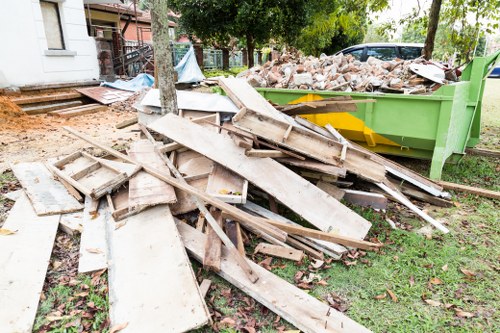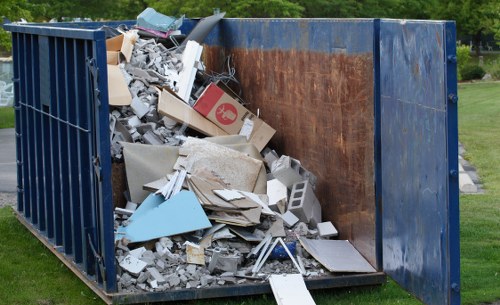Comprehensive Guide to Builders Waste Clearance in Stratford

When undertaking any construction or renovation project in Stratford, managing waste efficiently is crucial. Builders waste clearance in Stratford ensures that the site remains safe, compliant with local regulations, and environmentally friendly.
Proper waste management not only streamlines the construction process but also minimizes the environmental impact. Whether you're a professional builder or a DIY enthusiast, understanding the ins and outs of waste clearance can save you time and resources.
In this guide, we'll explore the essentials of builders waste clearance, the benefits of hiring professional services, and tips to optimize your waste management strategy.
Why Builders Waste Clearance is Essential

Builders waste clearance plays a vital role in maintaining the efficiency and safety of construction sites. Accumulated waste can lead to various issues, including:
- Health and safety hazards
- Environmental degradation
- Delays in project timelines
- Increased costs
By implementing effective waste clearance practices, builders can mitigate these risks and ensure a smoother workflow.
Moreover, responsible waste management contributes to sustainability efforts, aligning with modern construction standards and community expectations.
Types of Builders Waste

Construction projects generate various types of waste, each requiring specific handling and disposal methods. Common categories include:
- Concrete and Masonry: Debris from concrete, bricks, and other masonry materials.
- Wood and Timber: Offcuts, pallets, and untreated timber waste.
- Metals: Scrap metal from structural elements and fixtures.
- Plastics: Packaging materials, PVC pipes, and other plastic components.
- Hazardous Waste: Paints, solvents, and other chemicals requiring special disposal.
Understanding the types of waste generated helps in selecting the appropriate clearance and recycling methods.
Benefits of Professional Builders Waste Clearance Services

Opting for professional builders waste clearance services in Stratford offers numerous advantages:
- Efficiency: Professionals have the expertise to handle waste quickly and effectively.
- Compliance: Ensures adherence to local regulations and environmental guidelines.
- Cost-Effectiveness: Reduces the risk of fines and unexpected expenses related to improper waste disposal.
- Environmental Responsibility: Promotes recycling and reduces landfill burden.
These services alleviate the burden on builders, allowing them to focus on core activities without worrying about waste management.
Additionally, partnering with reputable waste clearance companies enhances your project's reputation for sustainability and responsibility.
Choosing the Right Waste Clearance Partner

Selecting a reliable builders waste clearance provider in Stratford involves considering several factors:
- Experience: Look for companies with a proven track record in construction waste management.
- Licensing and Certification: Ensure they comply with all legal requirements and hold necessary certifications.
- Service Range: Assess the variety of waste types they handle and the services they offer.
- Recycling Practices: Prefer companies that prioritize recycling and sustainable disposal methods.
- Customer Reviews: Check testimonials and reviews to gauge their reliability and service quality.
Taking the time to evaluate potential partners ensures a smooth and effective waste clearance process for your project.
Remember, a good waste clearance partner will not only handle your current needs but also support your future projects with consistent excellence.
Steps Involved in Builders Waste Clearance

The builders waste clearance process typically involves several key steps to ensure comprehensive waste management:
- Assessment: Evaluate the types and volumes of waste generated.
- Planning: Develop a clearance strategy tailored to the project's needs.
- Collection: Gather waste materials from the construction site.
- Transportation: Move the collected waste to appropriate disposal or recycling facilities.
- Disposal and Recycling: Ensure waste is disposed of responsibly or recycled whenever possible.
- Documentation: Maintain records for compliance and accountability.
Each step requires meticulous execution to maintain efficiency and compliance throughout the project lifecycle.
Implementing a structured clearance process helps in minimizing disruptions and maintaining a clean and safe work environment.
Eco-Friendly Waste Management Practices

Embracing eco-friendly waste management practices is essential for sustainable construction. Key practices include:
- Recycling: Sort and recycle materials like metal, wood, and concrete to reduce landfill waste.
- Reuse: Identify materials that can be repurposed for future projects.
- Waste Minimization: Implement strategies to generate less waste during construction.
- Proper Disposal of Hazardous Waste: Safely dispose of chemicals and hazardous materials.
- Green Certifications: Aim for certifications that recognize sustainable construction practices.
By adopting these practices, builders contribute to environmental conservation and enhance their project's sustainability profile.
Moreover, eco-friendly practices often lead to cost savings and improved project efficiency over time.
Cost Factors in Builders Waste Clearance

Understanding the cost factors involved in builders waste clearance helps in budgeting and optimizing expenses. Key cost determinants include:
- Volume of Waste: Larger projects generate more waste, increasing disposal costs.
- Type of Waste: Hazardous or specialized waste requires specific handling, which can be more expensive.
- Transportation: Distance to disposal sites and the amount of waste affect transportation costs.
- Frequency of Clearance: Regular clearance schedules may offer cost savings compared to sporadic services.
- Recycling Options: Utilizing recycling services can reduce overall disposal costs.
By analyzing these factors, builders can make informed decisions to manage waste clearance costs effectively.
Additionally, investing in efficient waste management can lead to long-term savings and better resource utilization.
Regulatory Compliance and Best Practices

Adhering to regulatory requirements is paramount in builders waste clearance. Key regulations in Stratford may include:
- Waste Disposal Permits: Obtain necessary permits for waste transportation and disposal.
- Health and Safety Standards: Ensure waste handling complies with local health and safety laws.
- Environmental Protection Laws: Follow guidelines to prevent environmental contamination.
- Recycling Mandates: Comply with regulations promoting or requiring recycling of construction waste.
- Reporting Requirements: Maintain detailed records and reports as mandated by authorities.
Staying informed about local regulations and implementing best practices ensures legal compliance and fosters responsible waste management.
Regular training and updates can help your team stay compliant with evolving waste management laws.
Innovations in Builders Waste Clearance

The builders waste clearance industry is continually evolving with innovative solutions aimed at improving efficiency and sustainability. Notable innovations include:
- Advanced Sorting Technologies: Automation and AI-driven systems enhance the accuracy of waste sorting.
- On-Site Recycling Facilities: Portable recycling units allow for immediate processing of certain waste types.
- Digital Waste Tracking: Software solutions monitor waste generation and management in real-time.
- Green Packaging Solutions: Sustainable packaging reduces overall waste from construction projects.
- Biodegradable Materials: Use of materials that break down naturally minimizes long-term environmental impact.
Embracing these innovations can significantly improve waste management practices and contribute to greener construction processes.
Investing in cutting-edge waste clearance technologies not only enhances operational efficiency but also demonstrates a commitment to sustainability.
Future Trends in Waste Clearance

The future of builders waste clearance in Stratford is poised for significant advancements. Emerging trends include:
- Circular Economy Models: Emphasizing reuse and recycling to create a closed-loop system.
- Smart Waste Management: Integration of IoT devices for real-time waste monitoring and management.
- Increased Recycling Targets: Stricter regulations pushing for higher recycling rates in construction.
- Green Building Certifications: Greater emphasis on sustainable waste practices for certifications like BREEAM and LEED.
- Collaborative Platforms: Digital platforms facilitating better coordination between builders and waste clearance services.
Staying ahead of these trends ensures that your waste management strategies remain effective and compliant with future regulations.
Adopting forward-thinking waste clearance practices can provide a competitive edge in the construction industry.
Implementing Effective Waste Clearance Strategies

To achieve optimal builders waste clearance in Stratford, consider implementing the following strategies:
- Early Planning: Incorporate waste management into the initial project planning stages.
- Regular Audits: Conduct periodic waste audits to identify areas for improvement.
- Training and Education: Educate your team on proper waste handling and segregation.
- Partner with Reputable Services: Collaborate with experienced waste clearance providers.
- Set Clear Goals: Define specific waste reduction and recycling targets for your projects.
These strategies not only enhance waste management efficiency but also contribute to overall project success.
By proactively addressing waste clearance, you can prevent potential issues and maintain a clean, organized construction site.
Measuring Success in Waste Clearance

Measuring the success of your builders waste clearance efforts involves tracking key performance indicators (KPIs). Important KPIs include:
- Waste Reduction Rates: Percentage decrease in waste generated over time.
- Recycling Rates: Volume of waste successfully recycled versus total waste.
- Cost Savings: Financial savings achieved through efficient waste management.
- Compliance Levels: Adherence to local waste disposal regulations.
- Team Engagement: Level of participation and commitment from your team in waste management practices.
Regularly monitoring these KPIs helps in assessing the effectiveness of your waste clearance strategies and identifying areas for improvement.
Continuous evaluation ensures that your waste management practices remain aligned with your project's goals and sustainability objectives.
Conclusion

Effective builders waste clearance in Stratford is a critical component of successful construction and renovation projects. By prioritizing waste management, builders can enhance site safety, reduce environmental impact, and optimize project efficiency.
Partnering with professional waste clearance services, implementing eco-friendly practices, and staying informed about regulatory requirements are essential steps towards responsible waste management.
Embrace the strategies and innovations discussed in this guide to ensure your projects are not only successful but also sustainable and compliant.
Take Action Today
Don't let waste management overwhelm your construction projects. Contact us today to learn how our expert builders waste clearance services in Stratford can streamline your operations and support your sustainability goals.
Book your service now and take the first step towards efficient and responsible waste management.